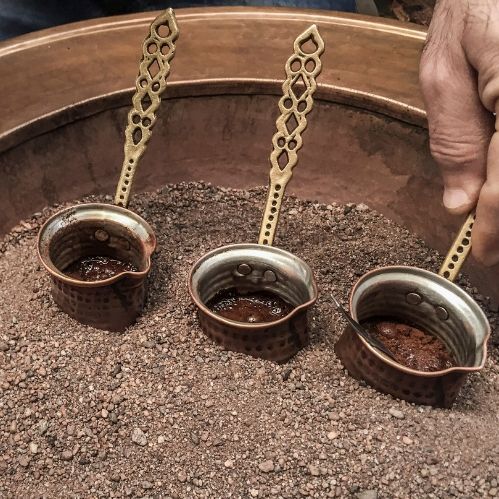Would you like to impress your guests with some hot, strong Turkish coffee ? Of course you would.
But how do you even make Turkish coffee ?
Let's see how we should go about actually serving this coffee, and in the process learn the basics about it.

Table of Contents
So what is Turkish coffee ?
Turkish coffee is more of a brewing method than anything else. In theory any coffee will work for Turkish coffee, bu the best to use is very finely ground (think espresso) Arabica beans.
It's coffee made with a small amount of water and a high amount of coffee, par-boiled for a few seconds, and then left to sit for a couple of minutes before serving.
This is the kind of coffee that is best appreciated by those who are okay with black coffee, since this is a very string coffee, and a little on the thicker side.
It's got plenty of coffee grounds on the bottom of the cups, and is not usually served with any milk or creamer.
Of course, there are traditions and traditions when it comes to Turkish coffee. It has one such tradition where the coffee is prepared via hot sand, and that's got to be one of the most charming ways to make coffee.
What makes Turkish coffee different
You've probably had coffee in several ways before. But what sets Turkish coffee apart from pretty much any other coffee type out there is the hands-on approach to it.
It started as a simple way to make coffee - pour cold water into a small pan, heat water, add ground coffee, bring to a boil, take off heat.
As with everything though, the best way to make Turkish coffee was refined, and the best way to serve it, as well as when to add the sugar, if you add any milk, and so on.
In short, it's a very specific and ritualistic way of brewing coffee. Much like the ancient Chinese and Japanese tea ceremonies, really.
If you were to make Turkish coffee any other way than the way I'll describe soon, you'd still get mostly the same product.
But respecting the ratios, and exactly how much to let the coffee sit on the heat, and what you should do after taking it off the heat will keep your coffee as close to the original as possible.
The ibric is as important as the grind size
One of the most important elements of Turkish coffee is the ibric, or small saucepan the coffee is made in. You'll sometimes find it under the name 'cezve', but it refers to the same item.
Why is the ibric so important ? Because as coffee and coffee brewing became very specific, so did the items used to make the best coffee possible.
This is how the ibric got its specific wide, flat bottom, with the outer curve. It's meant to catch most of the coffee grounds when you're serving the coffee.
If you have no ibric, the end result will be similar but definitely lacking in authenticity. And you'll get way more coffee dust at the bottom of your cup.
If you're looking to get a Turkish ibric, here's my recommendation.
This one by CopperBull is a 24 oz capacity ibric, and it will be able to serve even 5 people (or possibly more), depending on how small/large you're planning on making the servings.
It's heavy, thick, stamped copper, which means it will both look beautiful and heat evenly when you set it on the stove.
You can check the listing on Amazon here, and read the reviews as well.
And, if you're after the completely authentic experience, then you'll need the Turkish coffee set to go along with this ibric.
This set comes with 2 coffee cups, and a sugar holder, spoons, and a tray to hold everything. It's all done in traditional Turkish fashion, and the cups can be removed from their holders.
Keep in mind that these cups are small, since Turkish coffee is brewed in small amounts, and served so.
The set is dishwasher safe, and is actual metal so it will keep you a long time.
You can check the listing on Amazon here, and read the reviews as well.
How to brew Turkish coffee at home
Alright, now that you've got your ibric, you're ready to go.
I suggest you grind your coffee at home before brewing, to get the best taste in your Turkish coffee. For a very fine grind like you need here, both a blade and burr grinder are okay.
If you have no such grinder on hand, or grinding your own coffee is out of the question, consider buying espresso-ground coffee.
That's coffee that's pre-ground, and is specifically made for espresso. That is the finest size you'll find in commercial coffee, and it's going to do just great.
Make sure you look for 'espresso sized' or something similar mentioned on the coffee pack !
So, what you'll need for 2 servings of Turkish coffee are:
- 1 ibric of whichever size you want
- 5 oz of cold, fresh water
- 3 teaspoons of ground coffee
- if you want any sugar, add it now
Add the cold water to the ibric, and set it on high heat. Bring the water almost to a boil. Do not completely boil it, as you risk scalding the coffee.
You'll know your water is hot enough when it's starting to make small bubbles on the sides of the ibric, a few are rising to the surface, but there is no actual full-on rolling boil.
Once it's there, take the water off the heat and add the ground coffee. The coffee will bloom (foam), but it should not spill over, unless you have a very, very small ibric.
Once the coffee's settled down, stir it a bit. You'll notice bits of coffee in the foam. Do you best to sink them to the bottom.
Now, you have an option. You can either set the coffee on the heat for another 2-3 seconds, until it foams again and that's when you're done. Take it off the heat and let it sit for 2-3 minutes.
Or, you can leave it as-is, which will ensure more foam. This is something very sought after, but you run the risk of having stray grinds in the foam.
Never boil your Turkish coffee until you lose all the foam !
Once the coffee's had its rest, very gently pour it into two cups. You'll get about 2 oz of actual brewed coffee per cup. That's okay, since this is a very strong coffee and will have a high caffeine content.
You'll notice some coffee grinds near the end when pouring. Do your best to strain them, but remember that some grounds are expected at the bottom of the cup, so don't be too hard on yourself.
Aaaand you're done ! Two very beautiful, strong cups of Turkish coffee. Serve with a glass of cold water, and possibly with something sweet alongside it, like baklava or Turkish delight.
Use the hot sand method for authenticity
If you want to really, really amp up the degree of authenticity, you can try and make Turkish coffee in the sand. Hot sand.
This method originated from the hot sands of Turkey, especially in the less populated areas where there is more sand and the weather is much hotter.
To be fair, it's probably not 100% of Turkish origin, since many countries in the Arabian Peninsula share this method of brewing coffee. Who came up with it first, I don't know. And it doesn't really matter in the end.
What you do need to know is that you need hot sand. As hot as you can get it, and this can be anywhere between 50 to 100 C/122 - 212 F.
The way you do this is up to you, you could heat up some actual sand in a pan and then arrange the hot sand around the ibric and thus warm it.
I'm pretty sure there should be special items that look like a mini-garden, that can heat up sand in a container and you can place the ibric in that sand, much like with hot stones.
Using hot sand will make the coffee brew much slower, but it's much easier to control in the first place.
It's also going to keep the coffee warm for a much longer time, so keep that in mind when taking your first sip.
Can you make Turkish coffee with any grind size coffee ?
Well, no, you need a very specific grind size to make Turkish coffee.
Turkish coffee only uses very finely ground coffee, almost like a fine powder. This is partly because back when it became a thing, the coffee wasn't ground in many sizes, and near-dust was the standard.
Taking tradition into account, it's one of the reasons it's still done with very finely ground coffee to this day.
The dust-like consistency also makes the brewed coffee thicker, which has come to be perceived as desirable, and there have been customs associated with it, like people read fortunes in the dregs of coffee cups.
Now, if you were to make your Turkish coffee with slightly larger grinds, like when you will find in most coffee bags, that would still be fine. I mean the grind size that looks a lot like very finely ground pepper corns, the fresh ones.
The coffee would mainly end up the same.
But if you were to use larger grind sizes like for Moka for example, you'd have to let the coffee sit for a couple of minutes longer after you brew it. It's going to taste a bit different, but it's still coffee and will still form some foam on top.
If you're thinking of using coarse grounds like for French press, there's no point to it, unless it's the only way you can make coffee, at all. This is because while you will brew coffee, it will not be Turkish.
It's the small, tiny grind size that gives the taste and foam necessary to make it authentic.
Can you make Turkish coffee in any small saucepan ?
What if you really, really can't get your hands on an authentic ibric ?
The I guess any tiny saucepan will have to do. Though in this case it resembles more of a coffee without a coffee maker or filter method than a Turkish coffee.
As long as your saucepan is small enough to brew a few small servings, and as long as it can reasonably hold back most of the ground coffee then it should be fine.
It probably won't be as fine as an ibric, but it won't really ruin the experience.
This is actually the kind of coffee I make whenever we're out camping somewhere and it's the only reasonable way to make a cup of coffee.
A few tips on serving and drinking Turkish coffee
So you know now what you have to do to make Turkish coffee. There are some general guidelines to follow, and a few tips to remember. Here they are.

Never boil the coffee until you've got no foam left. That's not only far from the tradition - which in many cases states the number of bubbles is the number of coins you'll have in life - but it's also a sing of burnt coffee.
It will end up tasting too bitter and harsh, even if it is Arabica.
For the best results, stop just as you see the foam starting to rise. Keep stirring the coffee, but stop when you see no more ground coffee in the foam itself.
Serve the coffee only after it's sat for 2-3 minutes. Some say you should serve into cups, and then let it sit. But this gives you too much ground coffee at the bottom, which makes drinking the coffee more difficult than it has to be.
Remember to very slowly tip over the ibric, and gently pour out the coffee. You'll see some ground coffee, but the majority will be near the end. When you start to see it thicken, stop.
Some water will remain with the ground coffee. Let it be, and allow for that loss when planning how much water to add for how many cups of coffee.
Normally sugar is added to the boiling water, before adding any coffee. But if you somehow forgot, that's not the end of the world.
Always serve ice-cold water with Turkish coffee. It will help cleanse the tongue and refresh the guest. A sweet treat is optional, but welcome.
Final thoughts
I've had Turkish coffee pretty much every day in college. It's easy to make, and really easy to clean up afterwards.
Given how little space a dorm room has, having just one little ibric with me for coffee meant that I could easily have coffee without bringing it a drip filter or something similar.
I actually had this kind of coffee every morning until 2018, when I got myself a filter machine. It was only because Turkish coffee takes a few more minutes of dedicated attention, which I don't have anymore when I get ready for work.
In terms of taste, I think Turkish coffee beats most machine-made coffees (like espresso or filter or Moka), but it needs you to be there. Machines let you brush your teeth and get dressed in the meantime.
If you want to know more about coffee or tea, feel free to check the related articles below. Who knows what else you might find ?







